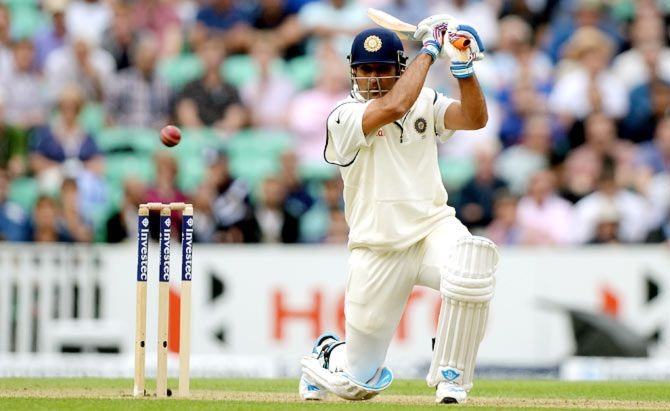
Millions of Indian cricket fans may not have heard of Midas from Greek mythology, but they know what the Dhoni Touch is. It took a young and inexperienced team to World T20 glory in 2007, and ended 28 years of World-Cup hurt on home soil four years later. It won India a Champions Trophy in 2013, and also took them to the top of the ICC’s Test rankings between November 2009 and August 2011. Those that have followed him in Chennai Super Kings (CSK) yellow will speak to you of five IPL titles and two Champions Leagues.
As a white-ball leader, Dhoni’s quality has never been questioned. His Test legacy is slightly more complicated, especially when it comes to England, where his many of his one-time teammates will try to win the World Test Championship against Australia at The Oval in June. Only in India did Dhoni appear in more than the 12 Tests that he played in England between 2007 and 2014. He led India in nine of them, and lost seven.
Even as India celebrates his leadership this week, after yet another heart-stopping triumph with CSK, the thoughts go back to the last time Dhoni played at The Oval, and the avalanche of criticism that came his way. India had started the 2014 series brilliantly, drawing at Trent Bridge and winning at Lord’s. But crushing defeats in Southampton and Manchester had transformed the narrative and the focus was squarely on India’s batting meltdown. Virat Kohli and Cheteshwar Pujara had come to England with lofty reputations, and been put through the wringer by Jimmy Anderson, Stuart Broad and friends.
Dhoni had made half-centuries in both defeats, and though the experts questioned his technique, it was remarkably effective. In fact, if you look at wicketkeepers that played more than 10 Tests on English soil, only Les Ames (49.68), Adam Gilchrist (40.07) and Matt Prior (38.10) average more than Dhoni’s 37.04. Names like Jonny Bairstow, Jos Buttler, Jeff Dujon and Ian Healy are all behind him.
On optional-practice day two days before that Oval Test, Dhoni was nowhere to be seen. It turned out that he had given the session a miss in order to go and shoot some rounds at the Metropolitan Police’s firing range. In an instant, the focus shifted away from Kohli and Pujara and their struggles. Dhoni’s behaviour was seen as a symptom of India’s lack of regard for Test cricket, and his own cavalier attitude to the red-ball format.
Also Read: India will Need Virat Kohli’s Fierce Focus at The Oval
India were routed by an innings yet again, despite Dhoni making a gutsy 82 in the first innings. He would play only two more Tests, in Brisbane and Melbourne, before abruptly bringing the curtain down on his Test career. Over the years, Dhoni has been so reclusive with the media that it’s unlikely we’ll ever hear his version of what happened at The Oval nearly a decade ago, but unwittingly or otherwise, it was genius leadership.
Maybe he just needed a day’s break? Perhaps he had always planned the shooting expedition. Or maybe he really was aware of the kind of heat his young batters were under. Whatever the motivation, his pre-match adventure put the spotlight squarely on him, and spared others much unflattering scrutiny.
Those who covered those tours of 2011 (0-4 d defeat) and 2014 (1-3) would also tell you what a poor hand Dhoni had been dealt. In 2011, several leading players were exhausted in the aftermath of the World Cup win, and a ten-team IPL season. Two or three of them had asked to skip a few IPL games, and seen their requests turned down. Once they got to England, they started dropping like flies. India were in the game at Lord’s till the final afternoon, and bossed the first couple of days at Trent Bridge, but the sight of a not-even-half-fit RP Singh taking the new ball in the final Test at The Oval summed up the unravelling that followed.
In 2014, despite the bright start, Michael Holding, who knew a thing or two about bowling in England, had warned that the bowlers lacked the fitness to last a five-Test series. Bhuvneshwar Kumar, for example, took 11 for 185 in the first two Tests, and 8 for 321 in the next three. While Broad and Anderson were hooping the ball around corners at Old Trafford and The Oval, India’s pacers ran out of puff.
In his press conferences, Dhoni invited further derision from the English media by attempting to make light of India’s woes. “We play only 15 per cent of our matches in such conditions,” he said when asked if the nature of the defeats bothered him. It was almost as if he didn’t mind the guns being trained at him as long as the muzzles were not directed at his players.
It was a far cry from 2007 and Lord’s, when Dhoni’s determined and unorthodox 76 not out helped India save a lost cause, and laid the platform for their only series victory in England since 1986. Then too, he cared little for conventional wisdom and set about accumulating runs and farming the strike as he thought best.
The last tour of England (four Tests in 2021, and the decider delayed to 2022) showed just how far Indian cricket has come since those dark days in 2011 and ’14. But the players that Dhoni shielded selflessly then would not have forgotten the lessons they learned. Whether it was Kohli, Pujara, or Rohit Sharma – who watched from the sidelines – they all got priceless insights into the true meaning of leadership.
Also Read: The WTC Final at The Oval is Rohit Sharma’s Tryst with Destiny



